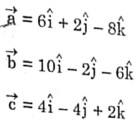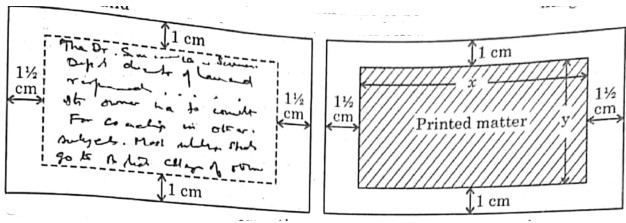This paper is divided into four sections – A, B, C and D.
Answer all questions.
Section A consists of one question having sub-parts of one mark each.
Section B consists of seven questions of two marks each.
Section C consists of nine questions of three marks each, and
Section D consists of three questions of five marks each
.
Internal choices have been provided in two questions each in Section B,
Section C and Section D.
The intended marks for questions are given in brackets [ ].
All working, including rough work, should be done on the same sheet as and
adjacent to the rest of the answer.
Answers to sub parts of the same question must be given in one place only.
A list of useful physical constants is given at the end of this paper.
A simple scientific calculator without a programmable memory may be used for
calculations.
Section-A
This section comprises multiple choice questions (MCQs) of 1 mark each
Question
1
A function f: R→R defined as f(x) = x2-4x+5 is:
(A) injective but not surjective.
(B) surjective but not injective.
(C) both injective and surjective.
(D) neither injective nor surjective.
Solution
View Solution
Question
2
If A =  is a skew-symmetric matrix, then the value of 2a - (b + c)
is a skew-symmetric matrix, then the value of 2a - (b + c)
Solution
View Solution
Question
3
If A is a square matrix of order 3 the value of |adj A| = 8 then the value of |AT| is :
(A) √2
(B) -√2
(C) 8
(D) 2√2
Solution
View Solution
Question
4
If inverse of matrix  is the matrix
is the matrix  then value of λ is :
then value of λ is :
(A) -4
(B) 1
(C) 3
(D) 4
Solution
View Solution
Question
5
If [x 2 0] then value of x is :
then value of x is :
(A) -1
(B) 0
(C) 1
(D) 2
Solution
View Solution
Question
6
Question
7
If xey= 1, then the value of dy/dx at x = 1 is :
(A) -1
(B) 1
(C) -e
(D) -1/e
Solution
View Solution
Question
8
Derivative of esin2x with respect to cos x is :
(A) sin x esin2x
(B) cos x esin2x
(C) -2 cos x esin2x
(D) -2 sin2x cos x esin2x
Solution
View Solution
Question
9
The function f(x) = x/2 + 2/x has a local minima at x equal to
(A) 2
(B) 1
(C) 0
(D) -2
Solution
View Solution
Question
10
Given a curve y = 7x - x3 and x increases at the rate of 2 units per second. The rate at which the slope of the curve is changing when x = 5 is
(A) -60 units/sec
(B) 60 units/sec
(C) -70 units/sec
(D) -140 units/sec
Solution
View Solution
Question
11
 dx is equal to :
dx is equal to :
(A) 2 log (log x)+c
(B) -1/log x + c
(C) (logx)3/3 +c
(D) 3/(logx)3 + c
Solution
View Solution
Question
12
The value of  dx is
dx is
(A) 1/6
(B) 1/3
(C) -1/6
(D) 0
Solution
View Solution
Question
13
Area of the region bounded by curve y2 = 4x and the X-axis between x = 0
and x=1 is :
(A) 2/3
(B) 8/3
(C) 3
(D) 4/3
Solution
View Solution
Question
14
The order of the differential equation  = 5 is :
= 5 is :
(A) -4
(B) 3
(C) 2
(D) not defined
Solution
View Solution
Question
15
The position vectors of points P and Q are p→ and q→ respectively. The point
R divides line segment PQ in the ratio 3 : 1 and S is the mid-point of line
segment PR. The position vector of S is :


Solution
View Solution
Question
16
The angle which the line x/1 = y/-1 = z/0 makes with the positive direction of Y-axis is
(A) 5π/6
(B) 3π/4
(C) 5π/4
(D) 7π/4
Solution
View Solution
Question
17
Question
18
If A and B are events such that P(A/B) = P(B/A) ≠ 0, then :
(A) A⊂B,butA≠B
(B) A=B
(C) A⋂B≠φ
(D) P(A)=P(B)
Solution
View Solution
Questions number 19 and 20 are Assertion and Reason based questions carrying
1 mark each. Two statements are given, one labelled as Assertion (A) and the
other is labelled as Reason (R). Select the correct answer to these questons from the codes (a), (b),
(c) and (d) as given below.
(a) both Assertion (A) and Reason (R) are true and Reason (R) is the
correct explanation of the Assertion (A).
(b) Both Assertion (A) and Reason (R) are true, but Reason (R) is not
the correct explanation of the Assertion (A).
(c) Assertion (A) is true, but Reason (R) is false.
(d) Assertion (A) is false, but Reason (R) is true.
Question
19
Assertion (A) : Domain of y = cos-1(x) is [-1, 1],
Reason (R) : The range of the principal value branch of y = cos-1(x) is [0,π]-{π/2}
Solution
View Solution
Question
20
Assertion (A) : The vectors

represent the sides of a right angled triangle.
Reason (R) : Three non-zero vectors of which none of two are
collinear forms a triangle if their resultant is zero vector
or sum of any two vectors is equal to the
third.
Solution
View Solution
Section-B
This section comprises very short answer (VSA) type questions of 2 marks each.
Question
21
Question
22
(a) Verify whether the function f defined by

is continuous at x = 0 or not.
OR
(b) Check for differentiability of the function f defined by f(x) = |x - 5|, at the point x = 5.
Solution
View Solution
Question
23
The area of the circle is increasing at a uniform rate of 2 cm2/sec . How fast is the circumference of the circle increasing when the radius r = 5cm ?
Solution
View Solution
Question
24
Question
25
Find the vector equation of the line passing through the point (2, 3, -5)
and making equal angles with the co-ordinate axes.
Solution
View Solution
Section-C
This section comprises short answer (SA) type questions of 3 marks each.
Question
26
(a) Find dy/dx if (cos x)y = (cos y)x
OR
(b) If √1-x2 + √1-y2 = a(x-y), prove that dy/dx = √(1-y2)/(1-x2)
Solution
View Solution
Question
27
If x = a sin3θ, y = b cos3θ, then find d2y/dx2 at θ = π/4
Solution
View Solution
Question
28
Question
29
(a) Find the particular solution of the differential equation
dy/dx - 2xy = 3x2ex2 ; y(0) = 5.
OR
(b) Solve the following differential equation :
x2dy + y(x+y)dx =0
Solution
View Solution
Question
30
Find a vector of magnitude 4 units perpendicular to each of the vectors
 and hence verify your answer.
and hence verify your answer.
Solution
View Solution
Question
31
The random variable X has the following probability distribution where a
and b are some constants:

If the mean E(X) = 3, then find values of a and b and hence determine
P(X ≥ 3).
Solution
View Solution
Section-D
This section comprises long answer (LA) type questions of 5 marks eac h.
Question
32
(a) If A = then find A-1 and hence solve the following system of equations :
x+2y-3z=1;
2x-3z=2;
x+2y=3
OR
(b) Find the product of the matrices 
hence solve the system of linear equations :
x+2y-3z=-4;
2x+3y+2z=2;
3x-3y-4z=11
Solution
View Solution
Question
33
Find the area of the region bounded by the curve 4x2 + y2 = 36 using
integration.
Solution
View Solution
Question
34
(a) Find the co-ordinates of the foot of the perpendicular drawn from the
point (2, 3, -8) to the line 4-x/2 = y/6 = 1-z/3 Also, find the perpendicular distance of the given point from the line.
OR
(b) Find the shortest distance between the lines L1 & L2 given below :
L1 : The line passing through (2,-1,1) and parallel to x/1=y/1=z/3

Solution
View Solution
Question
35
Solve the following L.P.P. graphically :
Maximise Z = 60x + 40y
Subject to x+2y ≤ 12
2x+y ≤ 12
4x + 5y ≥ 20
x,y≥0
Solution
View Solution
Section-E
This section comprises 3 case study based questions of 4 marks each.
Question
36
(a) Students of a school are taken to a railway museum to learn about
railways heritage and itg history.
An exhibit in the museum depicted many rail lines on the track near
the railway station. Let L be the set of all rail lines on the railway
track and R be the relation on L defined by
R={(l1,l2) : l1 is parallel to l2}
On the basis of the above information, answer the following questions :
(i) Find whether the relation R is symmetric or not.
(ii) Find whether the relation R is transitive or not.
(iii) If one of the rail lines on the railway track is represented by the
equation y = 3x + 2, then find the set of rail lines in R related to
it.
OR
(b) Let S be the relation defined by S ={(l1,l2) : l1 is perpendicular to l2 }
check whether the relation S is symmetric and transitive.
Solution
View Solution
Question
37
A rectangular visiting card is to contain 24 sq.cm. of printed matter. The margins at the top and bottom of the card are to be 1 cm and the margins
on the left and right are to be 11/2 cm as shown below:

On the basis of the above information, answer the following questions:
(i) Write the expression for the area of the visiting card in terms of x.
(ii) Obtain the dimensions of the card of minimum area.
Solution
View Solution
Question
38
A departmental store sends bills to charge its customers once a month.
Past experience shows that 70% of its customers pay their first month bill
in time. The store also found that the customer who pays the bill in time
has the probability of 0.8 of paying in time next month and the customer
who doesn't pay in time has the probability of 0.4 of paying in time the
next month.
Based on the above information, answer the following questions :
(i) Let E1 and E2 respectively denote the event of customer paying or
not paying the first month bill in time.
Find P(E1), P(E2).
(ii) Let A denotes the event of customer paying second month's bill in
time, then find P(A|E1) and P(A|E2).
(iii) Find the probability of customer paying second month's bill in time.
OR
(iii) Find the probability of customer paying first month's bill in time if it
is found that customer has paid the second month's bill in time.
Solution
View Solution
 is a skew-symmetric matrix, then the value of 2a - (b + c)
is a skew-symmetric matrix, then the value of 2a - (b + c)
 is the matrix
is the matrix  then value of λ is :
then value of λ is : then value of x is :
then value of x is :



 dx is equal to :
dx is equal to :  dx is
dx is  = 5 is :
= 5 is : 













 and hence verify your answer.
and hence verify your answer.



